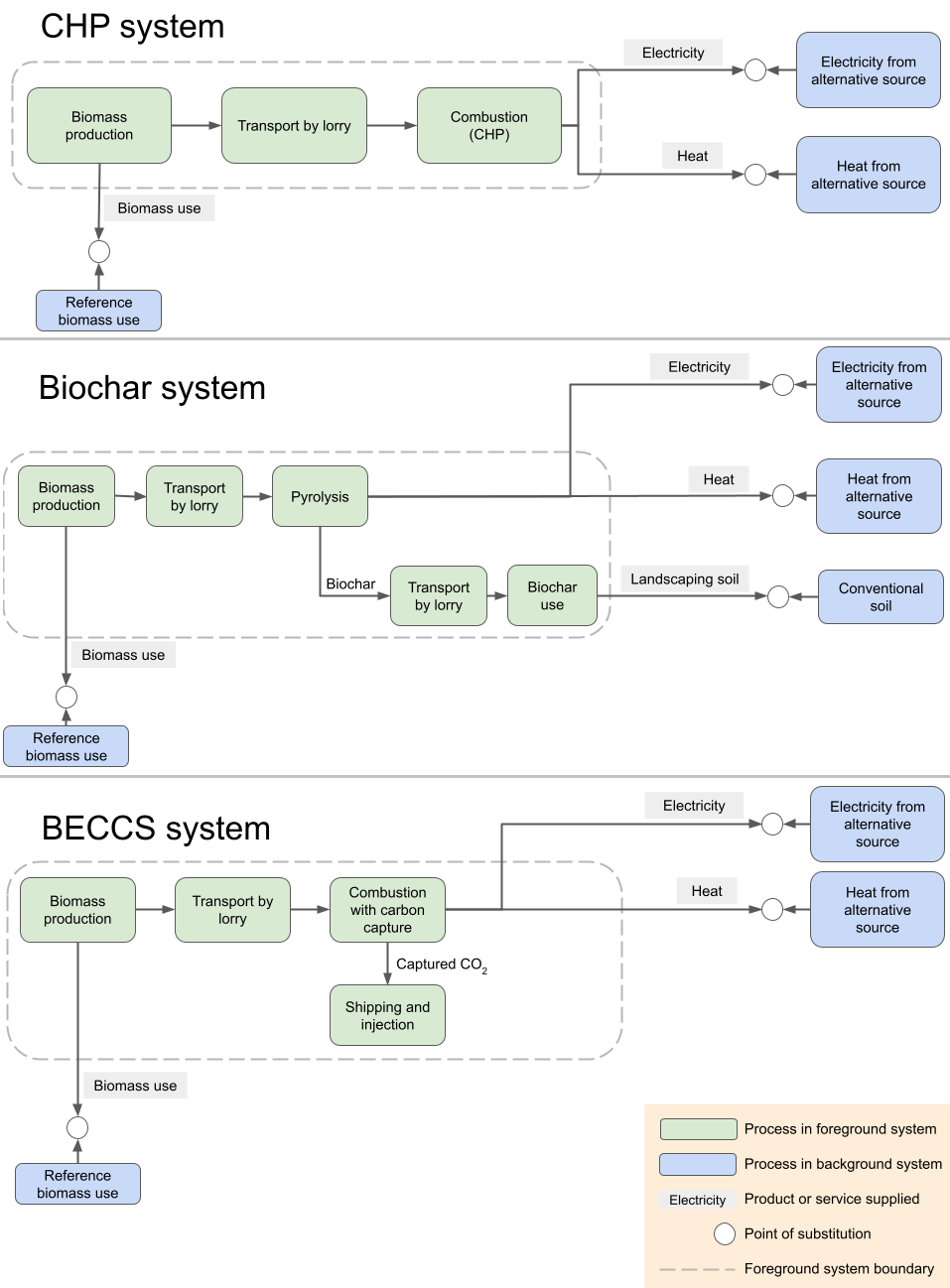
Research highlights
- En LCA studie av jämförande karaktär, med parametrar definierade för flera datapunkter, utfördes för tre olika bioenergisystem. Två av system innefattade koldioxidinfångning (Biokol och BECCS) och det tredje (CHP, kraftvärmeverk) var referenssystem utan koldioxidinfångning.
- LCA:n modellerade resultat för fyra olika funktionella enheter: värme, elektricitet, användning av biomassa, samt koldioxidinfångning (den sistnämnda endast för koldioxidinfångningssystemen).
- Resultatet är att koldioxidinfångningssystemen har en mindre klimatpåverkan än referenssystemet, i majoriteten av alla scenarion, och för alla funktionella enheter. När koldioxidinfångningssystemen jämfördes med varandra, berodde det mest klimatvänliga systemet på vilken funktionell enhet som användes.
- Eftersom systemen levererar flera funktioner uppstår allokeringsproblem i LCA:n. För att lösa dessa användes substitutionsmetoden (även kallad systemutvidgning) för att ta hänsyn till undviken miljöpåverkan. Majoriteten av variationen i resultaten härstammar från vilken substitution som användes för energisystenet; detta påverkade både klimatpåverkan för systemen i sig själva, men även deras klimatpåverkan i relation till varandra.
Vill du läsa mer?
Abstract
Purpose
Bioenergy with carbon dioxide removal (CDR) is increasingly proposed as an efficient way to mitigate climate change. This study examined the circumstances and methodological choices in which two CDR bioenergy systems were preferable to a reference bioenergy system from a climate change mitigation perspective. The CDR systems were also compared.
Methods
Three systems were modelled: two CDR systems (Biochar, bioenergy with carbon capture and storage (BECCS)), with a combined heat and power (CHP) system as reference. A parameterised life cycle inventory (LCI) model was developed and computed for all systems and four different functional units (FUs), resulting in different distributions of climate impacts. Contribution analysis was performed, followed by pair-wise comparison of all scenarios to establish their ranking. First-order Sobol indices were computed to assess the contribution of each parameter to total variance. When ranking of scenarios was strongly dependent on parameter values, decision tree analysis was applied.
Results and discussion
The CDR systems had a lower climate impact than CHP in most computations, across all FUs. On comparing the two CDR systems, the preferable system changed with FU. With heat or carbon sequestration as FU the Biochar system was preferable in general, while with electricity or biomass use as FU, the BECCS system had the lowest climate impact in most computations. For most system configurations, energy substitutions had a large influence and contributed most to the variance in results. The system ranking also depended on the reference activities in the background energy system.
Conclusions
The Biochar and BECCS systems were generally preferable to the reference CHP system from a climate mitigation perspective, particularly when the reference energy systems had a relatively low climate impact. However, FU and parameters affected the system ranking. For comparing BECCS and biochar, case-specific climate impacts will be decisive, but not always conclusive, as the choice of FU has such large impact on the results.
Recommendations
When conducting LCA of multi-functional systems, the use of several FUs, parameterised LCI, and contribution analysis allows for deeper investigation than conventional sensitivity analyses. When analysing the climate impact of bioenergy with or without carbon removal, it is especially important to perform sensitivity analysis on the energy background system, since it strongly affects the results.
Referens
Zakrisson, L, Azzi ES, Sundberg C (2023) Climate impact of bioenergy with or without carbon dioxide removal: influence of functional unit and parameter variability. DOI: 10.1007/s11367-023-02144-2
Kontakt: lisa.zakrisson@slu.se